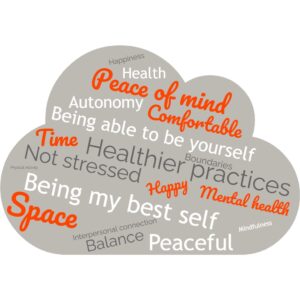If you are looking for a simple “5 tips to well-being” guide, then this article may disappoint. However, before you stop reading, let me tell you what it is about and then you can decide whether to read it all or to do a google search for “well-being tips”.
This year I have had my head in books, podcasts, articles and webinars about well-being. What has resonated with me is that the more one understands the “what” of well-being—what it is, what the components of it are and what the benefits are—the easier it is to begin map out your own well-being journey. Once you have this knowledge you are in a stronger position to explore the behaviours and habits needed to help your well-being to thrive. It’s at that stage that you may want to start googling for ideas and tips. In this article we explore these what´s, hence the title.
Still reading? Fantastic. Let’s start with…
Sorry, before we jump right in one more thing. I want to be clear on what well-being isn´t… it isn´t a fixed point that we are aiming to arrive at. We won´t suddenly wake up and say, “wow, I´ve reached peak well-being, now I can put my energy and attention towards my next goal”. It is dynamic, it is constantly changing and evolving, and it is very fragile. Therefore, our approach needs to be flexible and responsive. We should focus on integrating it into our life, so it becomes part of who we are and how we do things.
What is well-being?
Firstly, let me ask you a question: what does well-being mean to you? This is an important place to start because when we look at personal well-being, we place value and emphasis on different things. The word cloud below is how people on my workshop responded to the question. Your answer, whatever it was, indicates what you assign importance to. This is crucial as it influences what you give your attention to, how you evaluate your well-being, what priorities you set, and ultimately what behaviours and habits you choose to adopt to increase it. For example, if I define it as my physical health, I will assess my level of well-being on my physical condition and how healthy I feel. When trying to increase it, my priorities are more likely to focus on exercise or diet. Therefore, the behaviours and habits I choose will probably be more oriented towards physical fitness, losing weight etc.
Your answer, whatever it was, indicates what you assign importance to. This is crucial as it influences what you give your attention to, how you evaluate your well-being, what priorities you set, and ultimately what behaviours and habits you choose to adopt to increase it. For example, if I define it as my physical health, I will assess my level of well-being on my physical condition and how healthy I feel. When trying to increase it, my priorities are more likely to focus on exercise or diet. Therefore, the behaviours and habits I choose will probably be more oriented towards physical fitness, losing weight etc.
Whilst this is a good place to start, we also need to acknowledge that well-being isn´t one dimensional and so learning more about the different aspects of it helps to give us insight into what we need to focus on to get it to thrive. Therefore, I´d encourage you to look beyond your initial definition and familiarise yourself with what the research says… don´t worry, you don´t have to do additional research, just keep on reading this article.
Since there is no international consensus of what well-being means, I´ve picked out some definitions from experts in the field of mental health and positive psychology. Most definitions, including the dictionaries, reference physical and mental health, positive emotions, reaching our potential and a sense of meaning:
“A sense of health and vitality that arises from your thoughts, emotions, actions and experiences” Berkeley Wellbeing Institute
“…individual realises their own abilities, can cope with the normal stresses of life, can work productively and is able to make a contribution to their community.”
World Health Organisation
“A combination of feeling good as well as actually having meaning, good relationships, and accomplishment.” Martin Seligman
“A state of happiness and contentment, with low levels of distress, overall good physical and mental health and outlook, or good quality of life.” American Psychology Association
Now the final part of exploring “what is well-being?”, involves delving into the different areas that make it up. For this I am going to refer to Gallup´s classifications. Gallup, a global analytics firm, did a comprehensive study across 150 countries researching what matters to people and what contributes to their sense of thriving. From their findings they identified five broad categories that people say are important:
- Career Well-Being – how you occupy your time or simply like what you do every day
- Social Well-Being – strong relationships and love in your life
- Financial Well-Being – effectively managing your economic life
- Physical Well-Being – good health and enough energy to get things done on a daily basis
- Community Well-Being – sense of engagement you have with the area where you live.
Some sources also identify emotional well-being – how well you accept and manage your emotions and cope with challenges throughout life – as a separate category.
Now you have a good grounding of what well-being is you should be in a position to assess how yours is performing in each of the areas above. This will highlight what needs your focus.
Let´s look next at…
What are the components that contribute to our sense of well-being?
The components are the conditions needed for well-being to thrive. For this I will defer to the well-known and respected model devised by Martin Seligman, the founder of positive psychology. I use this model in my courses because it is both simple and based in vast amounts of research.
The model is called PERMA and represents 5 ingredients for thriving well-being:
- Positive Emotions – experience and access to emotions such as hope, joy, gratitude, optimism, happiness etc.
- Engagement – fully deploying skills, attention and strengths to a challenge, being immersed in an activity, finding flow etc.
- Relationships – connection to others, feeling supported, valued, etc.
- Meaning – a sense of purpose, belonging, contributing to something bigger than oneself
- Achievement – competence, improvement, working towards and reaching goals.
All these components are interdependent and when you cultivate or neglect one it impacts on the others. For example, if I feel overwhelmed at work then this might lead to a sense of underachievement as I struggle to get through my “to do” list. The impact of this might produce feelings of frustration, guilt or blame which aren´t conducive to high levels of engagement and could begin to effect the quality of my relationships inside or outside of work, and . . .
The lesson here is that for our well-being to flourish we need all components to be strong. However, different people have different priorities and needs for each component. For example, someone might need many positive and supportive relationships to feel like they’re meeting their needs for Relationships, whereas someone else might only need one.
It is important that you explore these components and identify what you need in each of them to thrive. Once you know this you can start to explore what you changes you can make.
What are the benefits of thriving well-being?
The reason I wanted to include this section is that why most people recognise that thriving well-being has positive impacts, it is less obvious what those impacts are. Understanding what the benefits are can act as a powerful catalyst to help us to create and sustain change:
- Lower risk of disease, illness and injury
- Better immune functioning
- Speedier recovery from illness or accidents
- Lower rates of burnout
- Higher levels of productivity
- Fewer sleep problems
- More active in the community
- More cooperative
- Report more satisfying relationships
For those of you who are partial to statistics, here are some. People who report high levels of well-being are:
- 47% more likely to adapt well to change
- 3 times more likely to report having an excellent quality of life
- 6 times more likely to engage fully in a task
- 50% less likely to look for new jobs
- Live 6 to 8 years longer
These findings are taken from studies that have directly researched well-being or studies that have focussed the components that contribute to it, such as relationships, positive emotions, engagement etc.
So, now to find out…
What can you do?
In my experience as a professional coach, gaining greater awareness about your own needs and circumstances puts you in a stronger position to make choices and implement actions that will be more rewarding and effective for you. With the deeper understanding that you now have of well-being (what it means, the categories and components) you can confidently make choices about what you need to get yours to thrive. Here are four simple questions to help you:
- What area of well-being do you need to focus on? E.g. Career well-being.
- Which of the 5 components of the PERMA model do you need to develop to help you with that area? E.g. For this area to thrive I want to feel a greater sense of belonging within the organisation. Therefore, I think the place I need to focus on is Relationships.
- What is one thing that you would like to happen in this component? E.g. I want a more honest and supportive relationship with my manager.
- What is one thing you can do to move towards this? E.g. ask my manager for a one to one meeting to ask for feedback.
Once you can be specific about what you need and want you can then begin to explore ways to get it. Here are some resources that might help you…
Resources
- Questionnaire – free online PERMA questionnaire that you can do to gain clarity on your strengths and where to pay attention. Click here
- Courses – I run two courses: one for individuals who want to look at their personal well-being and the second one for managers and leaders interested in well-being in the workplace. Click here to download the brochures.
- Website with lots of resources on how to look after your mind from Mindapples, a UK based organisation https://mindapples.org/you/yourmind/
- Article on 11 tips on mental health and well-being Columbia University, USA https://childadolescentpsych.cumc.columbia.edu/articles/11-tips-mental-health-well-being
- Article on 6 steps for improving social health from National Institutes for Health USA https://www.nih.gov/health-information/social-wellness-toolkit
If you have any questions after reading this article, then please don´t hesitate to contact me.
Be safe and be well
Emma
Disclaimer: If you are suffering from severe mental or physical health issues then seeking out support from a clinical, medical, or therapy-based practitioner would be the best place to start.

